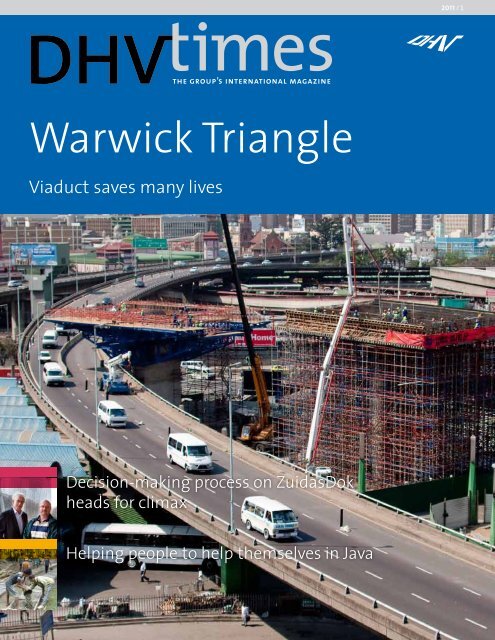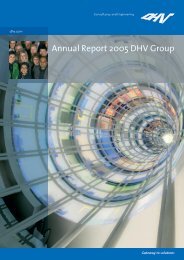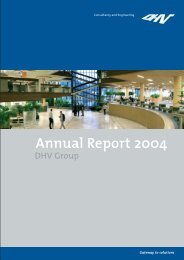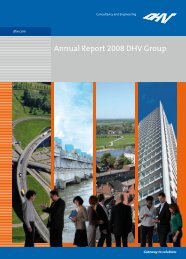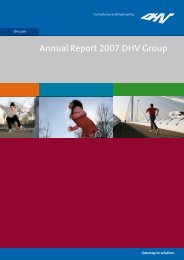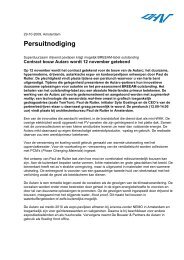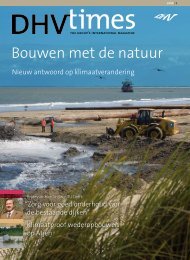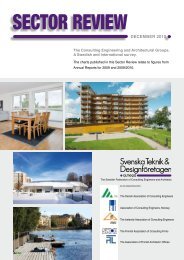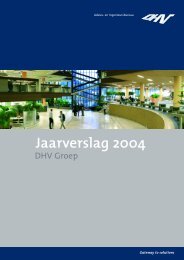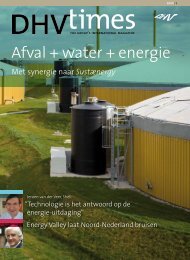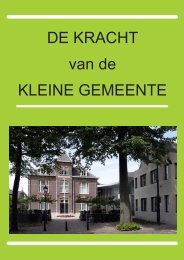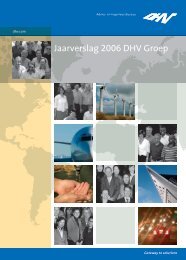Warwick Triangle
Warwick Triangle
Warwick Triangle
Create successful ePaper yourself
Turn your PDF publications into a flip-book with our unique Google optimized e-Paper software.
preface Bertrand van Ee, President Executive Board DHV Group 2 | 3 DHVtimes 2011 / 1contents4 coverstory<strong>Warwick</strong> <strong>Triangle</strong> Viaduct savesmany lives.7 news in brief- Water treatment in Vietnam.- Getting rid of traffic headaches.Giving peoplecentre stage8 on locationNew arch bridge for Torun.9 interviewDecision-making on ZuidasDokheads for climax.10 on locationNereda breaks sustainability records.11 dhv group news15 on location3D design translates technology forordinary people.16 reportCommunity building in Java.19 on locationBigger sea lock opens newperspectives.20 news in brief- Extra sand combats coastal erosion.- Water for Bhopal.21 how does it work?Using algae and sun to treat effluent.22 visionCultural dimensions on planning.23 colophontips and serviceThe DHV Group is a company of people, for people. Together with our customers, we areworking worldwide on high-quality, innovative solutions that contribute to the sustainabledevelopment of our living environment.This edition of DHV Times is devoted mainly to the people behind those solutions. Weshow you various projects that are improving the conditions in which people live, suchas the construction of a large viaduct in the South African city of Durban, the buildingof water treatment plants in Vietnam and the reconstruction of around 15,000 homesdestroyed on Java. One for one these are 'hard' engineering projects of great socialimportance with a big impact on the local community.But these hard projects also have a soft side, namely the mustering of support amongstakeholders. This side consists of empathy, talking and listening. This method of preparinga project, with attention being devoted to all stakeholders, is something to whichDHV attaches great importance and it is one of our most important tasks as consultants.Take the viaduct, for instance. A structure of this kind will remain in service for manyyears, so you have to give a great deal of thought to it before you start designing andbuilding. The question is whether it will fit into the physical space, and also whether itwill fit into the social patterns of the surrounding public market. After all, constructionrepresents an intervention in the community. A technically advanced solution withoutpublic support can amount to a waste of time, money and effort – i.e. it is not sustainable.The only way to create sustainable solutions is by directing optimum attentiontowards the interests of the stakeholders. We are convinced that these soft aspectsproduce hard, sustainable results for people and their living environment.Bertrand van EeCEODHV GroupPhoto cover: The <strong>Warwick</strong> <strong>Triangle</strong> Viaduct saves manylives. (Photo: SSI)
4 | 5 DHVtimes 2011 / 1In the run-up to the 2010 FIFA World Cup, the city ofDurban redeveloped <strong>Warwick</strong> <strong>Triangle</strong>, a particularlydangerous traffic intersection which is also the site ofa large community market. With the assistance of SSI,Durban was able to build a viaduct which makes<strong>Warwick</strong> <strong>Triangle</strong> far safer for both motorists andWith a population of over three million, Durbanis the third largest city in South Africa. In dents were the order of the day, with an aver-sand pedestrian visitors every day. Road acci-the days of apartheid, the predominantly age of over one fatal accident every week. Theblack population suffered social deprivation chaos also accounted for extremely high crimeand racial oppression. The city’s infrastructure figures.was poorly maintained and its economy wasat a standstill. For many years, remnants of Those familiar with the history of <strong>Warwick</strong> <strong>Triangle</strong>will know that the black community hadthis sad history remained visible at variouslocations in Durban, including <strong>Warwick</strong> <strong>Triangle</strong>,a chaotic mix of major transport hub here. This is one reason that so many hold itto fight long and hard for the ‘right’ to tradeand public market. There are converging major dear. It was over twenty years ago, not longhighways, taxi ranks and bus stops, while the after Nelson Mandela’s release from prison inhundreds of market stalls attract many thou-1990, that the country’s first democraticallyproject<strong>Warwick</strong> <strong>Triangle</strong> Outbound viaductcommissioning clienteThekwini Metropolitan Municipalityconstruction commenced11 March 2009construction completed30 April 2010contractorsGroup Five Pandev Joint Ventureproject managerSSIpedestrians. The project is notable in many respects,not least its very short lead time.“We had expected a project with a relatively highlevel of risk, but in the end it was one big party! ”elected government started to make plans forthe urban regeneration of <strong>Warwick</strong> <strong>Triangle</strong>.However, it took the World Cup 2010 toprompt real improvements. In October 2008,Durban received a government grant of 200million rand (approximately 20 million euros)with which to implement a project whichwould separate the major traffic flows from >>photo: ssi
coverstory <strong>Warwick</strong> <strong>Triangle</strong>photo: dhvThe viaduct has been the catalyst for a complete regeneration of the neighborhood.the market. The grant carried a strict condition:the project must be completed before thestart of the World Cup. To make this possible,eThekwini Metropolitan Municipality, responsiblefor the region which includes Durban,enlisted the help of SSI.Saving lives“We had just 68 weeks in which to build a viaduct,324 meters long and almost twenty metersin height, across one of South Africa’s busiesttraffic intersections,” recalls Brian Downie,SSI Project Manager. “This would only be possiblewith a streamlined Design and Constructtendering process. In South Africa, however, alltendering procedures are based on the traditionalmodel in which every phase has to becompleted separately, one after the other. Wewere the only engineering consultancy withany experience of the Design and Constructapproach, which would reduce the overallproject lead time by some forty weeks.”SSI’s on-site project manager Drew Wilsonadds, “The approach demands good cooperationbetween all stakeholders. We thereforedecided to form a team which would includenot only SSI but representatives of all localstakeholders. We then organized a seminar atwhich we provided full information about theimplications of the Design and Build methodand the project itself. We quickly reached consensus:everyone realized how important theviaduct would be. The prospect of a structurethat would actually save lives encouragedpeople to look beyond their own personalinterests. The taxi ranks and part of the busstation would have to be relocated, but thiswas achieved without any notable problems.Even people who would suffer considerablenuisance from the construction work took it allin their stride, setting the temporary inconvenienceagainst the final objective.”PartyIn February 2009, just four months after thelocal authority had finalized the project funding,the tendering procedure had been completed.The selected contractors, Group FivePandev, could begin work almost immediately.“An innovative design, excellent teamwork andexemplary cooperation from all stakeholdersmade it possible to complete the project fourweeks ahead of schedule,” states Brian Downie.“We had expected a project with a relativelyhigh level of risk, but in the end it was one bigparty! In a neighborhood long known for itscrime and social problems, everyone helped tocreate a very positive atmosphere. There was“We quickly reached consensus: everyone realizedhow important the viaduct would be”no vandalism or graffiti, and no one tried to stealany of our equipment. Everyone realized thatthe new viaduct would create new chances forthe whole community. A new spirit of freeenterprise emerged. Take the gentleman wholooked after the toilet cabins, for example.He rented them out to the stallholders so thatthey had somewhere to store their wares atnight. This viaduct has been the catalyst for acomplete regeneration of the neighborhood.Not only are there new roads, but new sanitaryprovisions and a new police station aswell. Thanks to our viaduct, there will be nomore deaths on the road, air pollution will bereduced, and the market area will be far safer.The people of Durban have at last got theirbeloved <strong>Warwick</strong> <strong>Triangle</strong> back.” •info Robin Hayestelephone + 27117986000e-mail robinh@ssi.co.zaphoto: ssi
news in brief Water treatmentnews in brief Transportation6 | 7 DHVtimes 2011 / 1photo: corbisphoto: delcanSerious polluted surface water leads to bad living conditions in Vietnam.Water treatment inVietnamDHV is to design a wastewater collection, treatment and drainagesystem for the Phù My district in South Vietnam. At present, wastewateris not treated at all, resulting in serious pollution of surfaceand groundwater. This in turn leads to worsening living conditionsin the region.DHV will design the wastewater system for both domestic wastewaterand that from industrial users to enable the region to growin a sustainable manner. The system will include the transport pipelines,the pumping stations and two treatment plants from whichclean water will be discharged into the Thi Vai River.The Phù My project is DHV’s third ‘ORIO’ project in Vietnam. ORIO isa financial support program of the Dutch government with NL EVDInternational acting as the formal commissioning client. The ORIOprogram is intended to assist economic growth in developing countries,reduce poverty, and involve the Dutch private sector in projectsin the less prosperous countries.DHV has also been commissioned to expand the water supply systemin the province of Ben Tre, while in Bà Ria-Vung Tàu province itis expanding and improving the water supply system in the ruralareas.In all projects, DHV is responsible not only for the designs and technicalspecifications, but also for the Environmental Impact Assessmentsand social-economic impact studies. •Crashed trailers are causing less congestion thanks to the Towing & RecoveryIncentive Program.Getting rid of trafficheadachesAtlanta is the third most congested city in the US, with an incredible57 hours of delay annually for each traveler. Every year, theaverage Atlanta motorist wastes 40 gallons of fuel sitting incongestion. These traffic problems also result in unnecessary emissionsof carbon dioxide which has considerable negative impact onair quality and the environment.Much congestion is caused by accidents involving tractor-trailers.Delcan has developed and implemented the Towing & RecoveryIncentive Program (TRIP), an innovative solution for mitigating thecongestion caused by these incidents. Since 2008, TRIP pays qualifiedheavy-duty towing and recovery companies monetary bonusesfor the quick clearance of large commercial vehicle incidents.TRIP promotes safe, fast and efficient management of incidents inan effort to reduce congestion, crashes and secondary incidents.Delcan is monitoring the results and investigating ways to expandthe program. The results show a dramatic reduction in the averageduration of commercial vehicle incidents, from 269 minutes in2007 to 106 minutes in 2011. This means that, on average, motoristscan spend 2.5 additional hours on more worthy activities, such asworking, helping children with homework, taking care of elderlyparents or volunteering in their communities, to name a few.TRIP is a result of collaboration among organizations including theGeorgia Department of Transportation, the Georgia Regional TransportationAuthority and the Federal Highway Administration. •info Tim Jeannételephone +84 4 39363889e-mail tim.jeanne@dhv.cominfo Christine Simontontelephone +1 404 320 1776e-mail c.simonton@delcan.com
on location Torun, ´ PolandNew arch bridgefor Torun´Every day more than 40,000 cars cross the only bridge that connectsthe two river banks of the Polish city of Torun. ´ The local publicworks authority commissioned DHV to supervise the building of anew bridge over the Vistula River. The two span tied arch bridge is akey investment for the city as it will improve traffic circulation androad safety. The new river crossing will also increase the economicattractiveness of the city and surrounding region, creating newprospects for the city and its citizens. •info Olga Kostro | telephone +48 56 476 06 33 | e-mail biuro@torun.dhv.plphoto: dhv
interview Ton Heddema and Richard Jorissen, ZuidasDok8 | 9 DHVtimes 2011 / 1Decision-makingon ZuidasDokheads for climaxThe Amsterdam business district of Zuidas is intersected by two motorways,two railway lines and one metro line. The wide array of rails and roads isretarding the growth of Zuidas into the economic powerhouse of theAmsterdam region. Under the name of ZuidasDok, a team of experts isworking flat out to solve this spatial puzzle. The Minister of Infrastructureand the Environment is due to announce her preferred solution this autumn.The team of experts is headed by Ton Heddema(A10 Project Manager) and Richard Jorissen(Project Director). The tension is rising forthem: will the road, train and metro all disappearunder ground, or will a variant be chosenwhere only the road gets buried? “We don'tknow which way it will go, but we do knowthat the political will exists to decide quickly”,says Jorissen. “We have in any event suppliedall the information necessary for a solidly validateddecision."The choice of one of the variants will mark theprovisional closure of a process that beganback in 1997. Since then the authorities involved(central government, municipality, provinceand metropolitan region) and private partieshave mulled over numerous variants andsolutions. It looks like a decision will be takenthis year. Partly thanks to the work done by theproject team, all stakeholders have lined upsquarely behind the project. Everybody agreesthat a good solution is needed to allow thearea to grow properly and to be ready for theincrease in the number of travellers and motorists.The number of rail passengers in thearea is expected to surge to more than100,000 a day in 2030. So time is pressing.SupportBoth men in charge of the ZuidasDok projectare satisfied with the progress achieved andwith the wide support among shareholders.Jorissen: “It's become a shared project. That’show it needs to be if you want to take a gooddecision. With integral projects like this, thekey is to let all interests converge.” Heddema:“It's great that we were able to factor in to thisproject the recommendations made by theElverding Committee. It means that all administratorsand financiers are involved and thiswill speed up the project.”Ton Heddema (left) and Richard Jorissen.ZuidasDok is a major constructionproject in the Zuidas-Amsterdam area.The project is a combination of theconstruction of homes and offices andthe enlargement and embedding ofthe capacity of the A10-South motor-zuidasdok and dhvway and public transport.The choice of one of the variants does notmean there will be no further changes. Theopposite is true. It is impossible to look intothe future so alterations must remain possible.“The ZuidasDok project will run for a long timeand won't be completed until around 2030”,says Heddema. “You need to design flexibly tobe able to adjust a plan in the course of time.After all, you can't make allowance for everything.”Jorissen adds: “What is needed now isimpact.the resolve to choose the alternative that offersthat kind of flexibility. We have an enormousopportunity to give Zuidas a boost that telephone +31 33 468 27 68info Jos de Langewill benefit the Netherlands as a whole.” •e-mail jos.delange@dhv.comAn important part of the plans is torelocate the transport modalities inpart underground. The concept for thisZuidasDok calls for the A10 motorwayto be put in a tunnel. Depending onthe alternative chosen, the trains willalso disappear underground. For eachalternative DHV is producing a generalplan of the A10 and examining thesafety, costs, risks and environmentalphoto: dhv
on location The Netherlands and South AfricaNereda breakssustainabilityrecordsDHV's Nereda® technology has broken many sustainabilityrecords thanks to its far smaller space utilization, considerablylower building costs, higher level of treatment andmore than 20% lower energy consumption. People andnature benefit from the unique properties of this innovativetechnology for the biological treatment of wastewater.Nereda thanks its success to the special properties of 'aerobicgranular sludge', which can possibly also cleanse ourwastewater of low concentrations of micro-contaminantsand heavy metals. The future will reveal all the other thingspossible with Nereda, because researchers are regularlymaking new and surprising discoveries. It recently emerged,for example, that the granules may be usable for the productionof high-quality natural resources. •info Gerben van Ommeren | telephone +31 33 468 24 24e-mail gerben.vanommeren@dhv.comphoto: dhv
10 | 11 2011 / 1The Danish government has approvedthe plans for the ‘FehmarnBelt’ fixed link between Lollandand the German island of Fehmarn,having determined that animmersed tunnel is the best solution.The Fehmarn Belt is one ofthe largest infrastructure projectsever undertaken in Europe, andwill provide a significant boost tothe economic, cultural and socialdevelopment of the region. Thetunnel design has been producedby the Ramboll-Arup-TEC jointventure, in which Tunnel EngineeringConsultants (TEC) – a consortiumof DHV, Royal Haskoningand Witteveen+Bos – plays a majorrole. A tunnel offers several advantagescompared to the alternativecable suspension bridge,both during construction and actualusage. There are benefits interms of technical, environmenillustratie:tecThe Danish government has approved the plans for the ‘Fehmarn Belt’ fixed link between Lolland and the German island of Fehmarn.greenporthollandinternationalDHV is one of the ‘founding fathers’of a new Dutch horticulturalpartnership called GreenportHolland International (GHI).The objective of GHI is to exportleading Dutch horticultural expertiseand innovations throughcollaboration between greenportbusinesses in the Netherlands.DHV will contribute its internationalexperience in integratedproject management and can deliverlocal support from offices inDHV’s home countries. The Dutchgovernment is supporting theinitiative with 2 million euro inannual funding. All over theworld initiatives are emergingfor metropolitan agriculture, foodclusters or agroparks near fastgrowingmetropolitan cities.Besides education, research andinnovation, GHI will focus ongreenhouse production, branding,and marketing logistics.Food clusters can be a profitablebusiness model while ensuringThe objective of GHI is to export leading Dutch horticultural expertise and innovations.photo: hollandse hoogtefood safety and the availabilityof sufficient quantities of highqualityfresh local food. •info Theo Klinktelephone +31 33 468 27 16e-mail theo.klink@dhv.comimmersed tunneltal and safety aspects, includingless adverse environmental impact,less hazard to surface shipping,and lower construction costs.Preparations are expected to takethree years and construction afurther six years, whereupon thetunnel is scheduled to open by theend of 2020. •info René Kuipertelephone +31 33 468 33 99e-mail rene.kuiper@dhv.commarionettetheatre inostravaThe Marionette Theatre in thecity of Ostrava (Czech Republic)has a new stage which can accommodateinteractive theatreshows. In these shows childrenand their parents can join theplay. The small-scale theatre alsooffers so-called ‘marionette therapy’for the disabled. The interactiveshows help the children todevelop their skills and expresstheir emotions. The main stage isin the basement. When the doorsare opened, the outside ‘stairs’ canalso be used for seating purposes.The project received EU funding
photo: dhvphoto: hollandse hoogteThe Marionette Theatre in the city of Ostrava (Czech Republic) has a new stage.The Hartel bridge across the Hartel canal in Spijkenisse undergoes a major refurbishment.under the local Regional OccupationalProgram (ROP). DHV wasresponsible for subsidy management,a feasibility study, a costbenefitanalysis and various consultancyservices. •info Jaroslav Sulertelephone +420 596 106 357e-mail jaroslav.suler@dhv.cominteractivedesign of hartelbridgeThe Hartel bridge across the Hartelcanal in Spijkenisse will undergoa major refurbishment. Atthe same time the capacity willbe increased by adding a drivinglane. The plan and the decisionmakingprocess were broughtforward because DHV got stakeholdersto brainstorm in a newinteractive setting called the IntegrationRoom, or i-Room forshort. This is a European first. Thei-Room is equipped with smartboards and computers that recordthe progress of decision-makingprocesses. The effects of decisionsare immediately visualized andmapped out, enabling stakeholdersto engage in a specific substantivedebate and immediatelyadopt joint decisions. •info Ruud Hulschertelephone +31 70 314 33 66e-mail ruud.hulscher@dhv.comusing batteriesinstead of petrolThe Better Place company is cooperatingwith DHV on the introductionof battery switchingstations, the electrical equivalentto the petrol pump. Early nextyear Amsterdam will become thefirst Dutch city with switchingstations where electrically poweredtaxis will be able to get theirempty lithium-ion batteries exchangedfor full ones within fiveminutes. The concept of BetterPlace is based on the unbundlingof car and battery. The motoristwill purchase the car and thenrent the battery from Better Place.The strategically located switchingstations will eliminate thelimited driving radius as a barrierfor purchasing an electric vehicle.DHV examined for Better Placewhere the switching stations canbest be located and the permitsthat are necessary. DHV also assistedwith applications for Europeansubsidies. For informationvisit: www.betterplace.com. •info Coen Jagertelephone +31 33 468 28 14e-mail coen.jager@dhv.comsludge study inportugalThe Better Place company is cooperating with DHV on the introduction of battery switching stations.photo: dhvÁguas do Noroeste has commissionedDHV to conduct a detailedstudy of integrated sludge managementsolutions. Águas do Noroesteis responsible for managingthe overall water cycle innorth-west Portugal.The company’s wastewater treatmentplants produce more than150,000 tons of sludge per year.Because of the study’s unique nature– it is the first in Portugal onsuch a large scale – the DHV teamconsists of Dutch and Portugueseexperts in sludge treatment technologiesand processes, transportand logistics, and environmentaland agronomic engineering. Oneof the study’s aims is to analyzeand calculate the contributionthat sludge can make to agriculturalproductivity. This will dependon the agronomic potentialof the sludge produced, the relevantlegislation, future trends,and the specific area’s crops andsoil types. If the sludge cannot beused for fertilization, alternativetechnical solutions will have tobe investigated. These may includeadvanced sludge treatmentor reusing sludge in electricityproduction or in the cement industry.•info Fernando Coelhotelephone +351 214 127 400e-mail fernando.coelho@dhv.com
12 | 13 2011 / 1photo: motDHV is mapping out the asset management organization of the Maasvlakte Oil Terminal (MOT).measuringwind load bycomputeravailability crucially importantto MOT and its customers. DHVwill make a systematic assessmentof the extent to which thecoach substantively and technicallyin ways including quickscans at interested companies toidentify possibilities for makingorganization meets the require-them sustainable or reducing en-For the next four years the 158 mments laid down in the PAS55vironmental nuisance. The feasi-high New Orleans residentialtower in Rotterdam will be thebackdrop for the largest windload test ever held in the Netherlands.The trial must demon-photo: hollandse hoogtestandards. DHV has been certificatedaccording to PAS55, thepremier standard for asset management.Certification covers allDHV's activities as asset managerbility of the possibilities will subsequentlybe computed. Zaanstadis willing to offer financial supportto companies that followthis path. DHV will assist thestrate that computer modeling(by means of Computational FluidDynamics) is a good alternativeto wind tunnel tests. DHVtook the initiative to organize thetrial and is working closely on itwith the Netherlands Organisationfor Applied Scientific Research(TNO), the Vesteda realestate company, facade builderBlitta, the Natural Stone Centreand the Facade ConstructionKnowledge Centre. This is thefirst time that such a trial is be-DHV will measure the wind load on the NewOrleans residential tower in Rotterdam.ing wind loads by means of computermodels. •info Rick Huizingatelephone +31 33 468 24 76e-mail rick.huizinga@dhv.commanaging oilterminal assetsof the Chemelot chemicals complexin the province of Limburg. •info Annemarie Kintelephone +31 40 250 93 48e-mail annemarie.kin@dhv.comsustainablecompanies inzaanstadA specially appointed sustainabilitycoach at the Zaanstad mu-companies in such ways as drawingup subsidy applications togetherwith the management.The contract will be completed inNovember. •info Thomas Metztelephone +31 33 468 36 42e-mail thomas.metz@dhv.comclean water forhai duonging held in the Netherlands andnicipality is going to assist localOn Wednesday 17 April, 2011 afterworldwide it is the largest of itsDHV is mapping out the assetcompanies in becoming leaders22 months of construction, thekind. Pressure meters and windmanagement organization of thein the sustainability field. Com-Hai Duong Water Supply Compa-speed meters will gather infor-Maasvlakte Oil Terminal (MOT),panies will be able to use theirny (HADUWASUCO) and DHV to-mation about the force that thethe world's largest crude oil ter-roofs, facades and other 'empty'gether with their stakeholderswind exerts on the building (andminal. MOT fulfils a pivotal rolesurfaces to conserve energy, pro-have celebrated the inaugurationits facade) over a period of fourin the logistics process betweenduce sustainable energy, or to re-of the Hai Duong water treatmentyears. The trial is intended tooil producers and the five Dutchduce emissions of odor, noise,plant in Hai Duong City, co-fi-contribute to the development ofrefineries. This role makes a highparticulate matter and NOx. DHVnanced under the Dutch ORETa general standard for determin-degree of asset reliability andis supporting the sustainabilityprogram. Participating in this Cer-
photo: dhvTesting the new water vapor system in the renovated DHV head office in Amersfoort, the Netherlands.The inauguration of the Hai Duong water treatment plant in Hai Duong City.The jury of the Dutch InnovationAward Fire Safety 2011 awardedDHV an honorable mention forthe new water vapor system installedin its renovated head officein Amersfoort, the Netherlands.The unique system produces adense vapor consisting of waterdrops in the area where the officefloors meet the building’s atriumspace. This screen of water vaporwill act as a barrier in the event offire, restricting the flames to theoffice floor where they developed.The water vapor will also have acooling effect and will make thesmoke less toxic. This system willbe a world first: the technique iscurrently not applied anywhereelse in the world in this form. Thewater vapor screen will replacethe physical partitions that tradiemonywere representatives ofthe Netherlands Embassy in Hanoi,the Government Office, theMinistry of Finance and the Ministryof Planning and Investment.DHV’s scope included all designand engineering services, constructionsupervision; the supplyof goods, equipment and capacitybuilding program. Implementedunder the Dutch ORET program,the project supplies 20.000m 3 ofclean and safe water during itsfirst phase and it will meet the demandof 95% of inner city residentsand 90% of suburban residents.The Hai Duong WaterTreatment Plant is the second watertreatment project implementedby DHV (after the Tan Hiep WaterTreatment Plant) under ORETin Vietnam. •info Lin Phantelephone +84 439363889e-mail linh.phan@dhv.vnwater vaporsystemphoto: dhvtionally divide office buildingsinto several fire compartments.The system, which is intended foruse in office buildings, was developedin-house by DHV. It is significantlycheaper than a sprinklersystem, requires less material,and is easier to install. •info Remko Noortelephone +31 40 250 94 16e-mail remko.noor@dhv.comcorporateresponsibilitysupplementIn March 2011 the DHV Group releasedits Annual Report 2010, ourfirst integrated reporting of Financialand Corporate Responsibilityperformance. Last May theDHV Group published the CorporateResponsibility supplement tothis report. This supplement providesadditional transparencywith more detail and backgroundon topics of special interest aboutCR. Highlights in 2010 include thecertification of our Business IntegrityManagement System, externalrecognition across theglobe for sustainability in projectsand innovation, and expandingour initiatives to help buildfutures through education. In ourown operations, we maintainedour focus on diversity and haveincreased the accuracy of measuringand compensating our CO2footprint. The CR supplement providesyou with an overview of ourapproach and includes examplesof projects and innovations whichwe hope you find interesting. Ithas been reviewed by an externalassurance provider and earnedthe GRI B+ level for which we applied.•info Marga Donehootelephone +31 33 468 37 40e-mail marga.donehoo@dhv.comdhvgroup.comConsultancy and EngineeringCorporate ResponsibilitySupplement 2010Gateway to solutions
on location Amersfoort, the Netherlands 14 | 15 DHVtimes 2011 / 13D design translatestechnology forordinary peoplephoto: dhv3The new 3D design method avoids miscommunication,saves tme and is more efficient.DHV is using new 3D design systems to reconfigure the Kersenbaan, ashort but important traffic corridor that runs along a railway line in thecentre of Amersfoort. Use of 3D techniques has brought the plan to lifeand the technology is no longer a barrier for local residents and themunicipal council.The road that runs parallel to the railway line –known locally as the Pon line – will be built witha tunnel beneath a roundabout. The railway linewill cross the roundabout above ground andwill be the first level crossing in a Dutch roundabout.The pre-existing sewers will also bemodified, while the below-ground infrastructurewill be relocated and noise barriers will beput up in the interests of nearby homes.The plans have given rise to numerous discussionsin the city and in political circles. Thismakes it all the more advantageous that thenew 3D design method illustrates the future3D animation Kersenbaan.situation, including homes and trees. Evenpeople without engineering knowledge caneasily 'read' the highly realistic moving illustrations.“This method of design is usable notonly during the design process, it's also a goodmeans of communication between the mayorand aldermen, the municipal council and thepublic,” says senior project leader Jeffrey Rampaart.“This new form of visualization allowsthe viewer to drive down the new Kersenbaan,so to speak. You immediately see the consequencesof certain furnishing choices. The3D design method is useful when informingstakeholders like Amersfoort residents.”illustration: dhvkersenbaanKersenbaan is a new road between the citycenter and the national A28 motorway.The road, 1.6 km long and 30 m wide, istightly surrounded by existing buildingsand infrastructure. The city needs the roadand work on it is being carried out in consultationwith the stakeholders. This hasmade Kersenbaan a challenging and complexproject. DHV is responsible for coordinatingall the engineering disciplinesinvolved in the project.The 3D animationis viewable in the digital DHVTimes.See www.dhvtimes.com.Avoiding miscommunicationRampaart: “The transparency of this designmethod avoids miscommunication, saves timeand is ultimately more efficient. It quickly becomesclear whether a change is desirable orundesirable. At presentations everybody canimmediately see the realistic effect on thesurroundings of relocating assets like publiclighting and the alteration of colors, shapes ordimensions. They're not just nice images, theydemonstrate the true effect because the technicalplan is the basis for the 3D model. Ittranslates engineering into perception andremoves a barrier for the local residents.” •info Jeffrey Rampaarttelephone +31 33 468 27 10e-mail jeffrey.rampaart@dhv.com
eport Community Building, Javaphoto: dhv
on location IJmuiden, the Netherlands 18 | 19 DHVtimes 2011 / 1Bigger sea lock opensnew perspectivesThe Noordersluis lock is the largest sea lock at IJmuiden. Since 1929 it has given seagoing vessels access to theNorth Sea Canal as they make their way to the Port of Amsterdam. The lock will require replacement 15 to 20years from now. Building a new and larger sea lock will raise lock capacity in step with the growth of shipping.The lock will open new perspectives for the port area. But the greater environmental burden of more noise andlight caused by the extra activities must be kept under control. The plans must also be compatible with thewishes of surrounding municipalities. At the same time the canal must continue to fulfill an important watermanagement function for the local water board. All of the effects and side-effects that the new-build lock willhave on people, nature and society are being examined by DHV and its partner Iv-Infra as part of a planningstudy being carried out for Rijkswaterstaat (Directorate-General for Public Works and Water Management).photo: hollandse hoogteinfo Wim Klomp | telephone +31 33 468 33 17 | e-mail wim.klomp@dhv.com
news in brief Coastal protectionnews in brief Waterphoto: dhvphoto: dhvShip Island, the biggest of the Mississippi Barrier islands.The construction of new water infrastructure in Bhopal.Extra sand combatscoastal erosionWhat will happen to the Mississippi coast if 15 million cubic metersof sand is added on Ship Island, the biggest of the Mississippi Barrierislands that protect the coast against storms? To find the answer aconsortium comprising CH2M HILL, DHV and Deltares will useadvanced computer models to study the sand replenishment andmorphological effects of different design variants.The islands are giving the coast dwindling protection. HurricanesCamille (1969) and Katrina (2005) split Ship Island in two over alength of 5.5 kilometers. The island chain is also being eroded bytides, tropical storms and dredging. The result is a risk of mainlandflooding and the reduction of biodiversity on the islands.The study is part of the Mississippi Coastal Improvements Programthat the United States Army Corps of Engineers (USACE) developedafter Katrina. Its objectives include restoring the natural sand balanceof and around the island chain as a sustainable solution to theerosion problems.The transfer of knowledge to the USACE specialists forms part of thecontract that must be completed in September. The models developedduring the study will later be used by USACE to fine-tune theplan, monitor sand movement and conduct flexible managementand maintenance. •Water for BhopalThe population of the city of Bhopal, the capital of Madhya Pradeshprovince (India), is currently about 2.1 million and is projected toreach 2.75 million by the year 2022. Population growth and rapidurbanization have a significant influence on water demand and areexerting pressure on the available water sources, leading to overexploitationof available resources.Although the city is blessed with a large sweet water lake (Bhojtal),the nearby Kolar Dam water reservoir and good annual rainfall,the local water supply is far from satisfactory on account of highlosses, inequitable distribution and non-coverage of vast newlydeveloped areas.To meet the growing demand water will be made available fromthe Narmada River more than 60 km away. To provide proper andefficient infrastructure, the Bhopal Municipal Corporation startedconstruction of 60 elevated service reservoirs, laying 90 km offeeder mains and approximately 900 km of water distributionpipelines, including installation of water meters, leak detectionsystems and establishing a 24x7 water supply to the whole ofBhopal city.DHV is providing construction supervision and quality controlconsultancy for the project. The assignment also includes contractadministration. •info Marius Sokolewicztelephone +31 33 468 32 53e-mail marius.sokolewicz@dhv.cominfo Mahmood Ahmadtelephone +91 11 40539303-06e-mail info.dhv-india@dhv.com
how does it work? 20 | 21 DHVtimes 2011 / 1Using algae and the sun to treat effluentDHV, SSI and South Africa’s Rhodes University aregoing to build a large demonstration plant forDHV, SSI and South Africa’s Rhodes University areMakana Municipality in Grahamstowngoing to build a large demonstration plant for(population 2500) to treat effluent by means ofMakana Municipality in Grahamstownalgae. Taking advantage of the South African sun,(population 2500) to treat effluent by means ofthe plant will produce clean water, biogas andalgae. Taking advantage of the South African sun,fertiliser for local use. The water is suitable forthe plant will produce clean water, biogas andirrigation or infiltration, while the biogas isfertiliser for local use. The water is suitable forusable as an alternative energy source and theirrigation or infiltration, while the biogas isusable as an alternative energy source and thealgae sludge as agricultural fertiliser, animal feed ora source of biofuel.algae sludge as agricultural fertiliser, animal feed orThe plant is a highly sustainable low-tech, low-costa source of biofuel.system for areas with a lot of sun and space. Treatmentoccurs without chemicals and is poweredThe plant is a highly sustainable low-tech, low-costsystem for areas with a lot of sun and space. Treatmentoccurs without chemicals and is poweredmainly by solar energy. Photosynthesis increases thepH, thus effectively killingmainly by solar energy. Photosynthesis increases thedisease-causing microorganisms in the water.pH, thus effectively killingdisease-causing microorganisms in the water.1 Domestic wastewaterflows to the treatment plant.1 Domestic wastewaterflows to the treatment plant.2 This is where the initialtreatment phase occurs2 and This biogas is where is obtained. the initialtreatment phase occursand biogas is obtained.Agricultural areaAgricultural areaVillageVillagebiogasbiogas3 In basin 2, algae andbacteria purify the water.3 This In kills basin disease-causing2, algae andbacteria microorganisms. purify the water.This kills disease-causingmicroorganisms.Basin 15 Algae sludge isfermented or used as5 agricultural Algae sludge fertiliser, isfermented animal feed or or used biofuel. asagricultural fertiliser,animal feed or biofuel.Basin 1algalgBasin 2Basin 24 The treated water flowsinto the river or is used for4 agricultural The treated purposes. water flowsinto the river or is used foragricultural purposes.RiverRiverillustratie: schwandt infographics
vision Jasper Fiselier, DHVCulturaldimensions inplanningphoto: dhvCulture is not only a strong driver of people’s behavior and their attitude toproblems, but also of their preference for specific solutions. The Dutch, forinstance, have developed a strong flood protection system mainly on thebasis of risk aversion combined with a strong sense of civic responsibilitythat problems must be tackled. This attitude has brought them largescale flood protection works and knowledge that is also very useful inother parts of the world. Nevertheless, these strategies are not a blueprintthat can be applied everywhere, since projects are also strongly driven byculture.The influential Dutch social psychologist GeertHofstede analyzed how different nationsapproach planning. Hofstede’s analysis wasinitially based on four dimensions: powerdistance, individualism, masculinity, and uncertaintyavoidance. He later added long termorientation as a fifth dimension to his modelin order to better accommodate an importantcultural attitude present in Asian countries.Based on these factors Hofstede was able tounderstand the way planning works in differentcultural contexts. A study in cognitive psychologyalso reveals remarkable differencesin the way planning is conducted in differentcountries. The Dutch tend to explore all optionsby means of scenarios and long termperspectives before selecting the preferredcourse of action. The Danes skip this phase andfocus mainly on optimization. The Germansseek to underpin their decisions with extensivefundamental research, but focus mainlyon the present. The development of long termperspectives does not receive a great deal ofattention in Germany. Besides differences inculture and procedure, there are also varyingtraditions with regard to planning.Of course there are also differences at the levelof organizations and project teams, the ’temporarytribes’ that develop their own ‘tribalculture’ during the time that they operate.Some teams work strictly by the rules, whileothers question the project’s goals and methods.The latter group has much more potentialfor innovation. There are ‘closed’ tribes that arepersonally motivated and tribes with a moreopen approach that truly represent ‘the people’.There is a strong connection between humanculture and the natural environment. A consultantneeds to recognize and work with culturaldimensions and differences, ensuring that decisionmaking takes into account both the humanand environmental dimensions. But dependingon the challenge, a specific ‘tribalculture’ may also be required for success.DHV acknowledges cultural drives and inte-curriculum vitaeJasper Fiselier has an academic degree inphysical geography with an emphasis onland use ecology and environmentalplanning. He has over 25 years of experiencein water related projects in morethan 20 countries.In past years Jasper has been involved inprojects that develop innovative greensolutions to protection works and regionalwater management. Critical to a gooddesign process is not only ecosystemknowledge but also financial engineeringand process management - competencesthat Jasper handles well.Jasper works asa project manager and strategic advisorfor international, national and regionalauthorities. In his present position as leadingprofessional he is developing DHV’sNature Driven Design approach in thefields of coastal management, urban watermanagement and climate adaptation.grates them into project and process management.In this way we can ensure the perfectmatch between culture and environment andbetween team and challenge that is needed toensure the project’s long term success. •info Jasper Fiseliertelephone +31 33 468 22 12e-mail jasper.fiselier@dhv.com
tips and service 22 | 23 DHVtimes 2011 / 1colophonThe DHV Group is a leadingengineering consultancy, knownfor top expertise and leadershipin sustainability.We are renowned internationallyfor excellence, especially in thefields of Water and Transportation.We serve clients throughlocal delivery of world-class solutions.The DHV Group operatesthrough an integrated network ofoffices in Europe, Asia, Africa, andNorth America.DHVTimes is published twice ayear and is available free ofcharge.Meet us at www.dhvtimes.comor call +31 33 468 20 15.editorial boardMachteld Blokhuis, Robin Hayes,Cheryl-Marie Hansberger, TimJeanné, Angela Marlet, Anneketer Mors, Gea Peek, Sandra vanPernis, M.S. Prakash, Vic Prins,Andreia Reis.Guest editor: Jasper Fiselier.In cooperation with Rob Grootand Anton van Renssen.editorial teamPeter Vlugt (editor in chief),Suzanne van der Werf (projectleader).P.O. Box 1132, 3800 BC Amersfoort,the Netherlands.Tel: +31 33 468 20 15,E-mail: dhvtimes@dhv.com.Other publications may usearticles with prior permissionand acknowledgement of DHV-Times as the source.translationDBF, Alphen aan den Rijn,the Netherlands.lay-outDHV, Shared Service CenterCommunications,Bert van Rootselaar.printDrukkerij Van Amerongen,Amersfoort.dhvtimes goesdigital!This is the last DHVTimes in print. Fromnow on you can receive our internationalmagazine in your mailbox. It’s faster,interactive and more sustainable.Visit www.dhvtimes.com and sign in. •international water week 2011The International Water Week Amsterdam, which takes placewebcams londonolympicsThe city of London is preparing for the2012 summer Olympics. The official websiteshows the latest photo’s and webcamimages taken of the Olympic Parkand venues like the big stadium and theaquatics center. The webcams show theprogress being made throughout theday and night. www.london2012.com. •photo: dhv photo: dhvfrom 29 October-4 November 2011, highlights integratedsolutions covering the entire water cycle. The event includesan exhibition, conferences and excursions to sites where solutionsare already at work. The internationally renowned tradeexhibition Aquatech Amsterdam and the world forum on deltasand coasts, Aquaterra, are part of IWW. DHV will be present atthe exposition, highlighting the waste water treatment toolNereda. DHV will also attend the congress, speaking a.o. aboutwater technology topics. For more information see:www.internationalwaterweek.com. •silent snowThe Arctic plains are an eminent example of nature’s untouchedbeauty: an endless nothing in which only few know how tosurvive. But a silent assassin is destroying the Inuit community.Chemical residues from all over the world accumulate hereinvisibly, poisoning both humans and animals. The Silent Snowproject aims to raise awareness of pollution caused by persistentpollutants and consists of both a short film and a featurelength documentary, educational material for schools and awebsite. DHV is sponsor of the project. www.silentsnow.org. •photo: dhv
dhvgroup.comGateway to solutions


